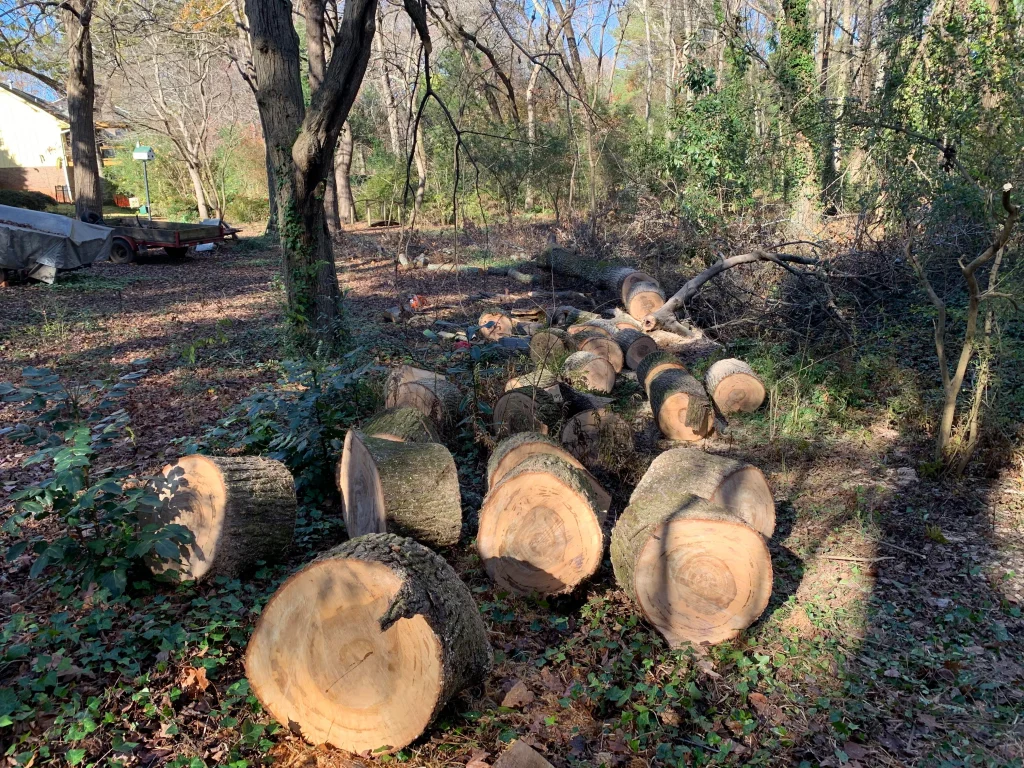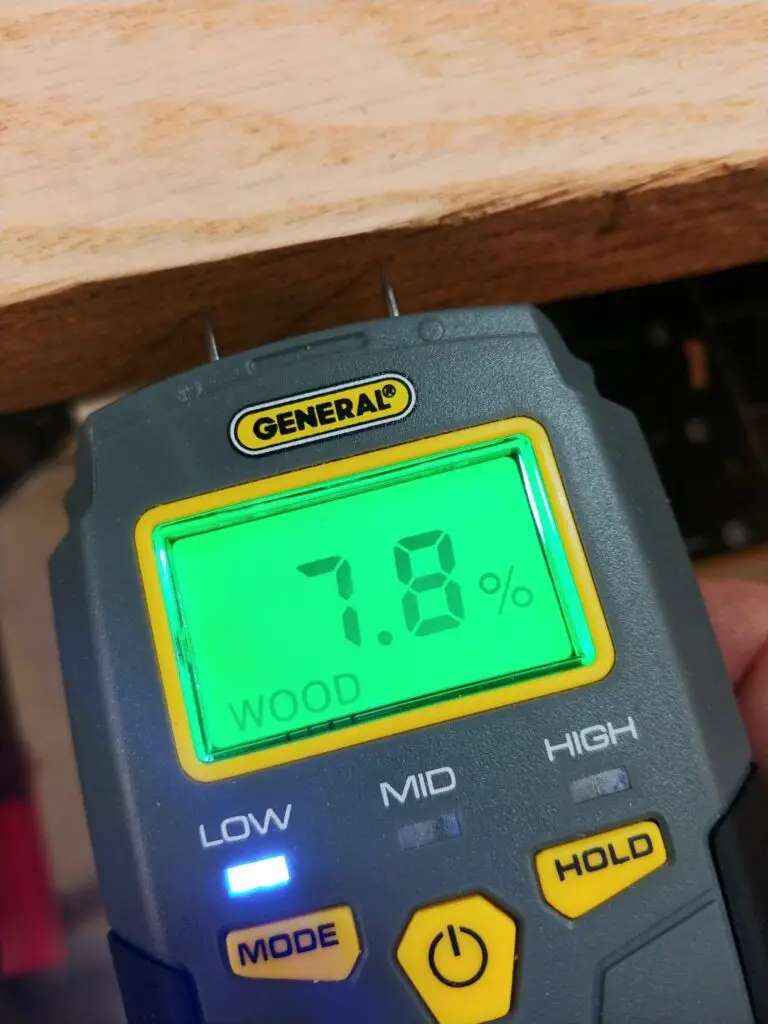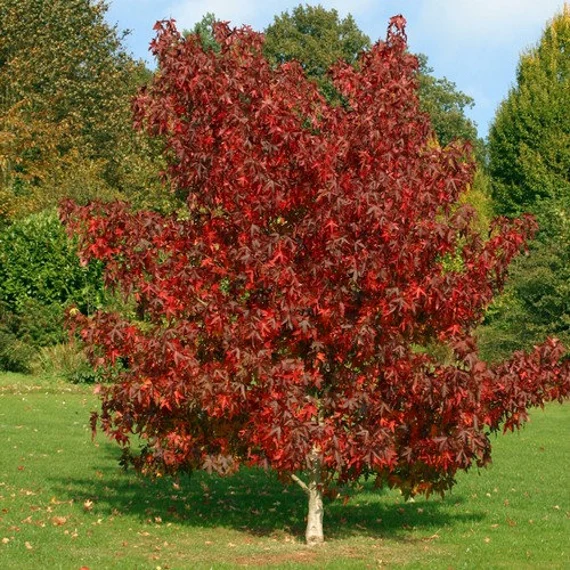Sweet Hum is poor firewood with a lower heat production than other hardwoods, is difficult to split, and does not produce good cooking coals.
Most commonly seen in full sun landscapes for their extravagant fall leaves, the sweet gum tree is a Southeastern tree also native to Asia.
Sweet gum is also popular for lumber as it has a beautiful core color and intricate grain patterns.
However, is Sweet Gum good for firewood?
Most would say no – mainly due to how difficult it is to split the wood and its inability to keep coals for an overnight fire.
However, sweetgum does have some redeeming factors that might convince you to add it to your woodpile this year.
Table of Contents
Summary
- Heat Production: 20.6-21.3 million BTU/cord
- Weight: 2,250-2,950 lbs dry wood
- Smoke: Low to Medium
- Smell: Indiscript/no smell
- Splitting Difficulty: Hard
- Seasoning Time: 1 year
The sweet gum tree is typically found in the Southeastern United States and thrives in warm and humid climates. The sweet gum tree has beautiful fall foliage and is commonly grown for ornamental purposes.
Sweet gum is a hardwood, but it burns hot and fast, is difficult to split, and does not leave behind good coals. If you are going to burn sweet gum, it is recommended to burn it mixed with other hardwoods.

Heat Production
Sweet gum firewood falls in the middle range of heat output, producing 20.6-21.3 million BTUs per cord.
Even with this average BTU rating, sweet gum burns quickly and produces poor-quality coals. As a result, sweet gum does not do well for overnight fires.
When burned, sweet gum also produces large quantities of ash.
Smoke Production
Sweet gum firewood produces a low to average amount of smoke when appropriately seasoned.
Unseasoned sweet gum will produce lots of smoke and give off large unburned particles and sparks.
Even when thoroughly dried, sweet gum does produce quite a few sparks.
While you should always use a screen or glass doors when burning inside, firewood that produces fewer sparks is safer. Wood that sparks heavily can create significant fire hazards.
When burning sweet gum, it is recommended to use a glass screen in front of your stove.
Seasoning Time
Seasoned wood has less than 20 percent moisture content. Firewood with a higher moisture content than 20 percent is harder to light and frustrating to burn. It also produces more smoke and creosotes buildup.
Sweet gum, when used for firewood, needs about a year’s worth of seasoning. The wood will shrink around 15% when fully dried, which is high compared to other hardwoods.
If you choose to season sweet wood for lumber purposes, you’ll want to steam the wood and then season it while it’s flat to help prevent bending and warping.
I personally recommend this General Tools Moisture Meter. It allows you to accurately gauge how wet your firewood is and whether it is sufficiently seasoned. Over time you can also see how quickly the moisture is dropping and how much longer you need to keep your firewood dropping until it is seasoned and ready to burn.
Press the sharp pins into the wood and you will quickly see the readout show the moisture ranging from 5% to 50%. It also has a Low/Mid/High indication depending on whether the wood is dry enough, so you don’t need to remember the actual values.

Burning Smell
Sweet gum does not have a strong, distinct smell.
However, when burned, unseasoned sweet gum or old sweet gum wood will smell musty.
Sweet gum firewood is not typically used for smoking meats or cheeses. I definitely don’t rate sweet gum as one of my top smelling firewoods.
Creosote Buildup
Creosote is a dark brown tar deposited from wood smoke that can build up on the insides of your chimney walls. It contains tiny unburned particles of wood and sap found in smoke.
Creosote can be extremely dangerous because of how flammable creosote is and will quickly start a chimney fire. Firewood with higher levels of sap will create more creosote.
When green, sweet gum wood has 79% moisture which is relatively high for a hardwood. It also contains high resin contents.
The sap of the sweet gum tree is used for medicinal purposes to treat ailments such as diarrhea, skin problems, cough, and ulcers.
Despite the high moisture content and sap, sweet gum produces low amounts of creosote when seasoned properly.
However, because sweet gum produces lots of sparks and popping, it is dangerous to burn sweet gum in a fireplace with pre-existing creosote buildup. The sparks can easily ignite the creosote and cause a hazardous chimney fire.
Splitting
Sweet gum’s most diminishing quality is how difficult it is to split. It is challenging to split sweet gum with an axe or maul and even tricky with a hydraulic splitter.
Sweet gum has a spiral grain with interwoven fibers which makes splitting the wood more like tearing it apart.
The fibers become warped and packed tighter as the wood dries. You’ll want to split sweet gum as green as possible.
If you choose to split sweet gum with an axe, make sure you start on the edges, work your way around the wood, and then into the core.
Different Types/Species
You can quickly identify sweet gum trees by their five-pointed star-shaped leaves and spiky fruit. In the fall, the sweet gum tree’s leaves turn brilliant red, yellow, orange, and purple colors. The trees grow to be 150 ft in the wild with 2-3 ft diameter trunks.
The bark of sweet gum trees is also distinguishable by thot deeply furrowed ridges and their light gray-grayish brown color.
The spikey fruit of the sweet gum tree is known as “gumballs,” and they grow to be 1-3 inch balls. The balls start green but mature to a dark brown color and turn hard. Gumballs, despite their name, are extremely painful to step on, so watch out!
There are 15 species of sweet gum trees in the genus Liquidambar – which means liquid amber. Liquid amber refers to the sweet gum tree’s sap, which is sweet and sticky. Sweet gum trees are native to North America, Asia, and the Mediterranean. In the U.S., you can find sweet gum trees in Connecticut to Florida and west into Texas, Missouri, and Oklahoma.
American Sweetgum Tree (Liquidambar styraciflua)
Found in the United States, the American Sweetgum tree has all of the characteristics of a typical sweet gum tree, as mentioned above. These trees are planted mainly for landscaping purposes and are low maintenance. They can be found in USDA growing zones 5-9. The root systems of the American Sweetgum tree are very shallow, which means they are often not planted by buildings but instead out in open areas.
Sweetgum ‘Slender Silhouette’ Liquidambar styraciflua ‘slender silhouette’)
The sweetgum ‘Slender Silhouette’ trees are unique in that they are about 50 ft tall, fully matured, and grow in a column shape. Very tall and skinny, or slender as the name says. They still have the same characteristics of a star-shaped leaf and spiky gumballs. They are fast-growing and grow great in tight spaces. The Slender Sihouette grows excellent in full sun and can be found in USDA zones 5-8.
Fruitless Sweetgum (Liquidambar Styraciflua ‘Rotundiloba’)
As the name suggests – the Fruitless Sweetgum tree does not grow spiky gumballs. This is a favorite among landscapers because this variety does not make a mess like the other sweet gum trees. You will find these trees in large garden landscapes in USDA zones 6-9, growing to be around 70 ft tall. Also unique to the Fruitless Sweetgum is their rounded star-shaped leaves, as opposed to the other varieties, which are pointed.
Sweetgum ‘Worplesdon’ (Liquidambar Styraciflua ‘Worplesdon’)
The Worplesdon variety of the sweet gum trees is smaller in height than the others. In the fall, the Worplesdon sweetgum tree produces a fiery red leaf and looks similar to a Japanese Maple tree. Worplesdon trees will grow well in full sun and in USDA zones 5-9.
Sweetgum ‘Variegata’ (Liquidambar Styraciflua ‘Variegata’)
Different from the other sweet gum trees, the Variegata tree has creamy-yellow and green star-shaped leaves. This tree is bushy and medium-sized.
Sweetgum ‘Lane Roberts’ (Liquidambar Styraciflua ‘Lane Roberts’)
Great for small and medium landscapes, the Lane Roberts sweetgum tree is known for its black leaves in the fall.
Oriental Sweetgum (Liquidambar Orientalis)
Unique for its small lobed leaves, the oriental sweetgum tree is a small tree or large shrub and can be found in USDA zones 7-9.
Chinese Sweetgum (Liquidambar Formosana)
The Chinese sweetgum tree likes warmer weather and grows quite tall, from 100-130 ft. This variety of sweetgum also has unique leaves with only three lobes.
Chang’s Sweetgum (Liquidambar Acalycina)
Found in Asia, Chang’s sweetgum tree is a small tree that can easily be misidentified for a maple tree.
Sweetgum ‘Gumball’ (Liquidambar Styraciflua ‘Gumball’)
The Gumball variety of trees is a dwarf tree that only grows about 6 ft tall. The Gumball sweetgum tree is a lovely addition to any landscape and boasts purple-red leaves in the fall.
Sweet gum tree sap is known as storax or styrax and has been historically used for medicinal reasons. Storax has antimicrobial, antifungal, and anti-inflammatory agents. The healing benefits of the sweet gum sap were used to treat skin infections, coughs, dysentery, sores, and wounds. The sweet gum tree leaves were mixed with tobacco and burnt as a sedative. Today, the sap is used in medicine such as Tamiflu. It has been proven to heal and help many ailments of the body and brain.

Comparison to Other Woods
Here we see some of the most popular firewoods to burn indoors compared to sweet gum firewood.
| Firewood | BTUs | Ease of Splitting | Coals | Overall Quality |
| Green Ash | 20.0 | Easy | Good | Excellent |
| Maple | 25.5 | Easy | Excellent | Excellent |
| Bur Oak | 26.2 | Easy | Good | Excellent |
| Sweet Gum | 20.6 | Difficult | Poor | Poor |
Sweet gum has a lower BTU compared to other household favorite hardwoods. Because of its difficulty to split and its poor coal production, most find that sweet gum is not a great firewood for their home.
Many find that the effort to split sweet gum is not worth it. If you end up with sweet gum firewood, mixing it with oak or other hardwoods is recommended.
FAQs
Can you burn sweet gum firewood in a firepit?
Yes. Sweet gum can be burned in a fire pit and may work well for your next camping trip. Because sweet gum burns hot and fast, it will be great for an evening fire that must be put out by the night’s end. Just make sure your fire is distanced from your tents since it pops and sparks quite a bit.
Is sweet gum firewood safe to burn in a fireplace?
Sweet gum is safe to burn in a fireplace if you have a glass door or screening and your chimney is clean. Do not burn sweet gum in a fireplace that has a large creosote buildup.
How much does sweet gum firewood cost to buy?
Sweet gum wood is valued relatively low, so it is hard to find for purchase on its own for firewood purposes. Sweet gum is often cut down and given away by power line and other industrial companies.
Final Thoughts
Sweet gum trees burn hot and fast but are frustratingly challenging to split. Once split, the wood will leave you with no coals and lots of sparks and ash. Sweet gum is definitely not a favorite to burn when compared to other hardwoods.
If you have an excess of sweet gum in your area and are low on wood for next season, it may be a good choice to add it to your wood pile. Remember to mix it in with other hardwoods to cut down on the smoke and sparks. However, if you have a large quantity of other hardwoods, you may decide to pass on sweet gum firewood.
